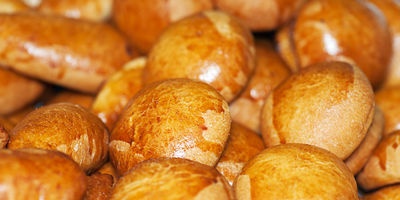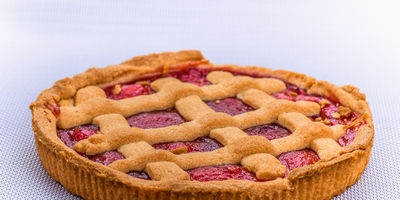|
 The pancake dough should have the thickness of a good sour cream. The pancake dough should have the thickness of a good sour cream.
- Do not start baking pancakes before rubbing the pan thoroughly with fine salt.
- Have you got a new baking sheet? Don't rush to use it. After cleaning, rinsing with hot water and drying, it must be covered with a thin layer of vegetable oil and heated in the maximum oven temperature. The "hardened" oil film will no longer allow the baking sheet to rust and the baked goods from sticking to the metal.
- Milk heated to 25-30 °, or the same warm water, quicker activates the yeast diluted in these liquids. This means that the dough will rise faster.
- Soft and sticky doughs are easier to roll out by covering them with oiled paper.
- To prevent lumps from forming in the flour during kneading, water or milk is poured into it, and not poured flour into the liquid.
- To make yeast dough, you have to spend from 20 to 50 g of yeast for every kilogram of flour. Why such difference? If you season the dough with eggs, butter, sugar more, then more yeast will go to it.
- It happens that the dough, rising "on one side", that and look will fall out. Its even rise will be fully ensured by a few pasta stuck in it.
- You can check whether the dough has stood well by pressing on it with your fingers: the deepening made in a good batch will literally disappear before your eyes.
- Try pouring a few tablespoons of fat into the pancake batter and stir. You will see. that you only need to grease the pan once - for the first pancake. The rest will go like clockwork.
- It is more practical to store flour not in chests, but in bags. This is because it is easier to pour it over from time to time so that it does not cake.
- Once you have pancakes, do not rush to add whipped protein to the dough until it rises completely. This is not economical, because then yeast would have to be added to speed up the slowed rise. By the way, the protein must be "pressed" into the dough, and not "stirred" in a circle.
- Do not knead the shortbread dough for a long time, otherwise it will take a long time to rise.
- The reason for the poor baking of the dough, oddly enough, is often an excess of fats mixed in it. They clog the pores through which the hot air in the oven can hardly penetrate into the depths of the baking.
- Biscuit dough, like shortbread dough, "does not like" to be kneaded for too long.
- If the dough "runs away" and you are not yet ready to bake it, stop it rising by covering it with paper soaked in water.
- When kneading dough with raisins, it often turns out that the berries in the baked bun are somewhere "thick", and somewhere "empty". Before kneading, rinse the raisins in hot water and roll the raisins in flour while still wet. They will immediately lose their "desire" to gather nearby, and you will be provided with an even distribution of raisins in baking.
- Sugar, if you put a lot of it in the dough, can "deceive" the hostess. It will quickly brown the crust of the pie, while the filling is not baked. The fact is that, melting from a high temperature, it closes the pores in the baking and thus prevents hot air from penetrating into the depths of the baking. So use sugar in moderation.
- Those who believe that touching the dough before it rises is harmful for it are wrong. On the contrary: "crumpled" 2-3 times during the ascent, it will "work" faster.
- But the dough, suitable for pancakes, is really not worth worrying about. It is enough to stir it - bubbles of carbon dioxide will pop out, and you will not see lush pancakes.
- Ready for baking is considered to be a dough that does not stick either to the hands or to the wall of the dish.
- To successfully cut a hot pie, it is not enough to have a sharp knife. It still needs to be dipped in boiling water or held over a stove flame.
 Do not fry the pies in fat until you sweep away the flour adhering to their dough: it will burn, and this will not decorate your culinary creations at all. Do not fry the pies in fat until you sweep away the flour adhering to their dough: it will burn, and this will not decorate your culinary creations at all.- The temperature in the oven when baking dough products is considered "moderate" when it is heated to 130-180 °. "Medium" - when 180-220 ° and "high" when 220-270 °, and select one of three depending on the type of dough, size and shape of products.
- The gas oven is preheated 10 minutes before baking, the electric one 25.
- What kind of tricks have not been invented to save the pies from burning. If the cake sticks to the sheet, it is separated by a strong thread stretched in the hands, held under the cake. In this case, some housewives prefer to hold the sheet over steam, and if the cake is not removed from the mold, then the hot mold is either put on a pan filled with water, or wrapped in a wet towel.
- Make sure to prevent your baked goods from burning before placing them in the oven. For example, if you sprinkle a leaf with a thin layer of fine salt, the cake (even if it is already charred) will not stick to the leaf.
- There are surprises: the top of the cake is about to burn, and the bottom is far from baked. In this case, an experienced hostess will quickly cover the top of the cake with paper well dipped in water and the cake will be saved.
- Every now and then, looking into the oven, we may spoil the taste of the future product (oxygen rushes into it, a temperature drop occurs). So, cabbage pie definitely doesn't "want" to be disturbed for the first 15 minutes after being put in the oven.
- If, looking into the oven, you see that one edge of the pie is almost burnt, and the other has not yet browned, then there are two ways to balance the events: unfold and insert the sheet "backwards", or put a metal bowl under the threatening charring side of the pie with water.
- The hostess should know at least some of the "signals" that dough products are ready. You can't get good quality by eye definition. But if, say, a loaf taken from a hot sheet and snapped with a finger on the crust, as it were, "rings", then do not doubt its high quality. The housewives also got a knack to find out if the cake is ready with the help of ... matches. They pierce the crust with them and take out. If the match remains dry, there is nothing more for the pie in the oven to do.
- Piercing pies during baking, you have to do it for other reasons (and, of course, not with matches, but with forks). This is if you have the filling "on suspicion" that it will lag far behind the dough in terms of readiness. Especially the eye and the eye are needed with the "gifts of the forest" that have got into the cake, which have a strong skin. Through punctures, the heat will reach the filling much faster.
- When cooked, the pie (with some exceptions) is not immediately removed from the oven. It simply turns off the gas or current. Cooling down in the warmth, the cake "ripens". And some of the pies in the cooling mode are even distributed in volume, "puff".
B.P. Brusilov - Culinary savvy
|